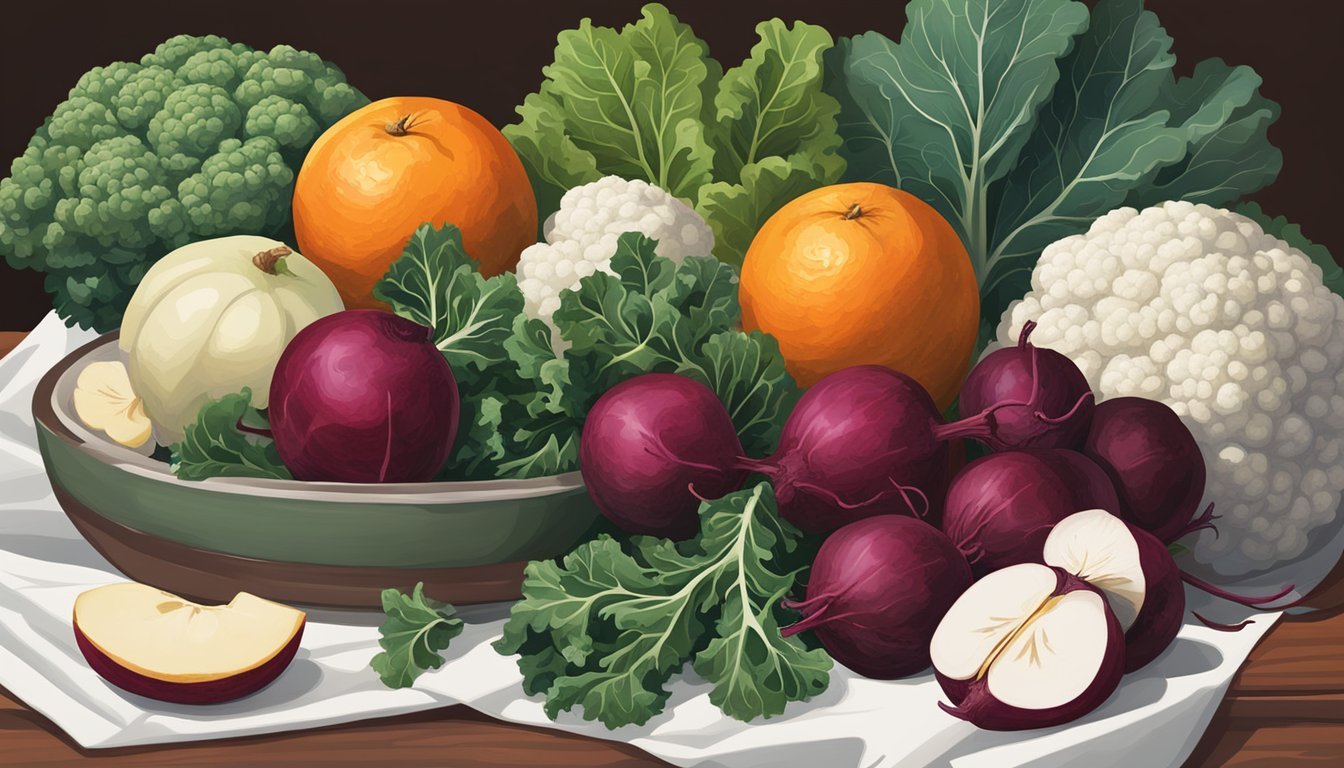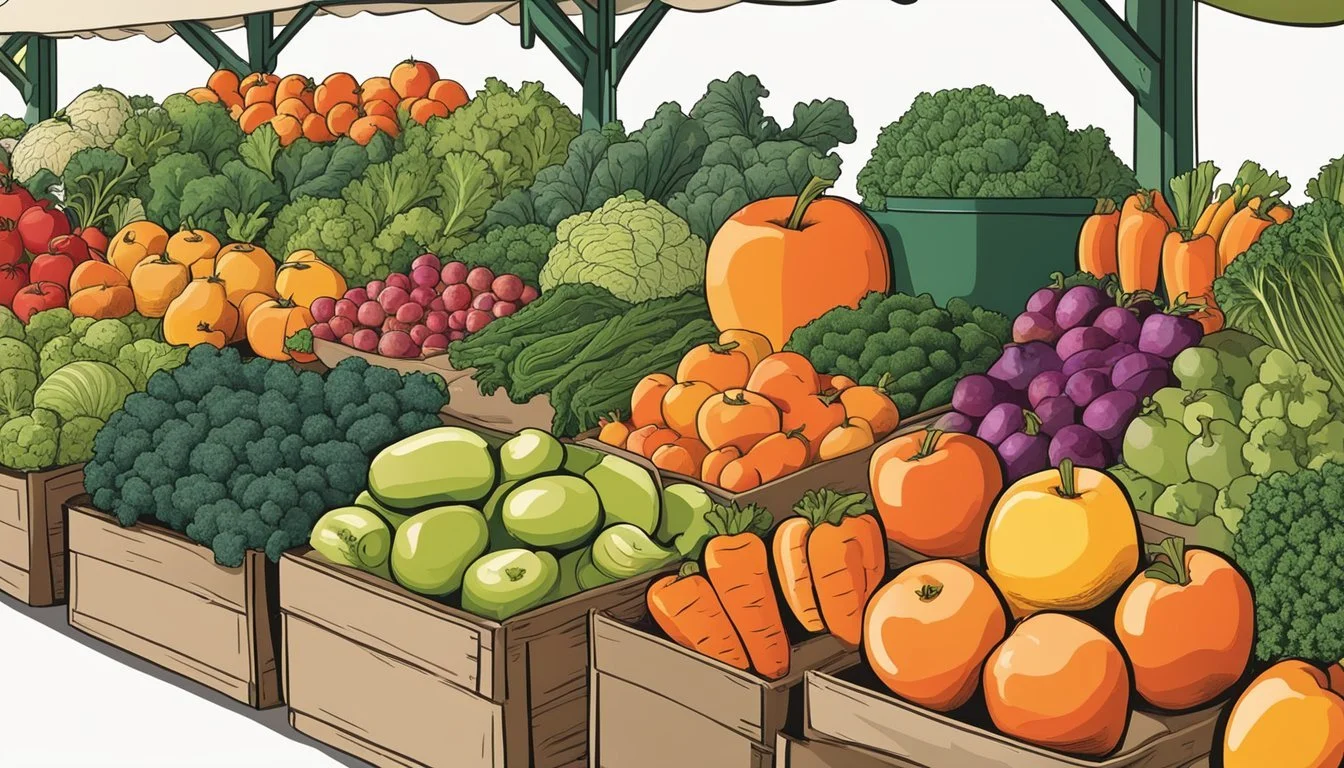Minnesota Seasonal Fruit & Vegetables in February
Your Guide to Winter Produce
This Article is Part of our Minnesota Seasonal Fruit & Veg Calendar
Minnesota's frigid winters necessitate a shift in available produce during the month of February. While the state is known for its lush summer harvests, the winter season is characterized by a reliance on stored produce and greenhouse-grown crops. Consumers seeking fresh, local fruits and vegetables during this time may find options more limited, with many farms offering goods preserved from the previous growing season or sourced from controlled environments.
The assortment of fruits and vegetables found in Minnesota during February typically includes those with a robust shelf life or those that can withstand the colder temperatures. Root vegetables such as carrots, onions, and potatoes are commonly available from storage, as well as hardy winter squashes and apples. Greenhouses provide fresh greens like lettuces and herbs, though the variety may not be as extensive as in warmer months. Consumers mindful of seasonal eating take this time to enjoy the stored harvests while anticipating the return of a broader selection as the seasons change.
Understanding Minnesota's Climate and Seasonal Produce Cycles
Minnesota's varied climate plays a significant role in the availability of fruits and vegetables throughout the year. The state experiences four distinct seasons, including cold winters and warm, humid summers, which impact what crops can grow and when they can be harvested.
Winter in Minnesota, extending from November through March, is characterized by freezing temperatures and snow, limiting local crop availability. Indoor greenhouses and storage crops, like potatoes and apples, often make up the winter produce selections.
As spring arrives around April, the thaw begins, and early-season crops like radishes, spinach, and green onions are among the first to be harvested. Summer brings a plethora of options from June through September. During this peak season, produce such as strawberries, tomatoes, broccoli (how long does broccoli last?), and cabbage thrives, offering the freshest tastes for consumers.
Fall signifies a transition as the state's produce cycle prepares for cooler weather. This time is ideal for pumpkins, squash, and root vegetables, which are typically harvested before the first frost. The changes in seasons directly influence harvest times and crop availability.
Here's a summary of seasonal produce cycles:
Winter: Few fresh crops, reliance on storage and greenhouse-grown produce.
Spring: Arrival of early-season vegetables and greens.
Summer: Abundance of diverse produce, including fruits and vegetables.
Fall: Harvest of cool-weather crops and preparation for winter storage.
Farmers adapt to these cycles, utilizing growing methods like hoop houses to extend seasons. Consumers can expect varying produce selection as the year progress, reflective of Minnesota's distinct climate-driven cycles.
February's Seasonal Selections
In February, Minnesota offers a variety of root vegetables and hardy greens that withstand the cold climate. The state's seasonal produce includes a robust selection of root vegetables, leafy greens, cruciferous vegetables, and resilient alliums.
Root Vegetables and Tubers
Minnesotans enjoy a bounty of root vegetables in February. Staples such as potatoes and carrots are plentiful, often stored effectively to last through the winter. Other notable roots including parsnips, turnips, beets, and rutabagas are available and can be prepared in various ways, from mashed to roasted.
Root Vegetables Available:
Potatoes
Carrots
Parsnips
Turnips
Beets
Rutabagas
Residents also have access to winter squash, which stays well in storage, adding a sweet note to the season's flavors.
Leafy Greens and Cruciferous Vegetables
Despite the chill, some leafy greens persevere, and cruciferous vegetables stand strong. Kale and cabbage are hearty greens that thrive in colder temperatures, and are often incorporated into seasonal dishes. Brussels sprouts (how long do brussels sprouts last?)are also part of this group, offering a nutty and savory component to meals.
Cruciferous Vegetables to Look Out For:
Broccoli
Cauliflower
Brussels sprouts
Additionally, spinach and chard can be found in colder months, though selections may be less abundant than in the fall.
Alliums and Hardy Veggies
Alliums like onions, leeks, and garlic are essential flavor foundations available during February. They remain a staple in the kitchen for their robust flavors and versatility in cooking.
Allium Vegetables:
Onions
Leeks
Garlic
Moreover, hardy vegetables such as celery (how long does celery last?) and celery root might also make an appearance in February's harvest, rounding out the selection of produce that can withstand Minnesota's winter months.
Fruit Availability in February
In February, Minnesota's fruit selection is largely influenced by storage capabilities and includes hearty citrus fruits imported from warmer climates.
Citrus Fruits
During the cold month of February in Minnesota, consumers can expect to find a variety of citrus fruits available. Shipped in from warmer regions where they grow year-round, these fruits provide a welcome burst of flavor during the winter.
Oranges: This staple citrus fruit is at peak availability, including varieties like the navel and blood oranges.
Lemons: Bright and tangy, lemons are readily available and add refreshing zest to dishes.
Grapefruits: This larger citrus, with its distinctively bittersweet taste, is another common find.
Storable Harvests
Local fruit choices in February are typically limited to those that store well from the previous harvest season. These fruits are often kept in controlled conditions to prolong freshness.
Apples: Varieties that store well, such as Honeycrisp and Haralson, are usually accessible from local storage.
Pears: Certain types of pears remain in good condition when stored properly and can be found in markets.
Seasonal Recipes and Preparation Ideas
In February, Minnesotans turn to hearty dishes that make the most of winter produce, such as root vegetables and citrus, to create warming meals that are both nutritious and comforting.
Warming Soups and Stews
Winter in Minnesota is an ideal time for hearty soups and stews. Utilizing root vegetables like carrots, beets, and other cruciferous vegetables like broccoli, one can prepare a variety of soups to keep warm. A simple carrot and ginger soup can be both soothing and invigorating, while beet soup, with its deep red hue, offers earthy flavors. On the other hand, a broccoli cheddar soup provides a creamy texture and rich taste.
Recipe Suggestion:
Ingredients: mixed root vegetables, broth, herbs
Preparation: roasted, then simmered and blended
Oven Roasted Favorites
Roasting is a preparation method that intensifies the natural sweetness and flavors of winter produce. Roasted broccoli can serve as a delicious side dish or can be incorporated into a baked casserole with cheese and rice. Roasted carrots and beets take on a caramelized edge that pairs well with meats or can be added to salads for a substantial meal.
Guide to Roasting:
Preheat oven to 425°F (220°C)
Toss vegetables in olive oil and seasoning
Spread in a single layer on a baking sheet
Roast until tender and lightly browned
Refreshing Citrus Dishes
Citrus fruits, while not native to the cold climate of Minnesota, are readily available during the winter months and can add a refreshing zing to dishes. A simple citrus salad with slices of orange and grapefruit can be a bright side dish or a palate-cleanser. Using lemon to dress steamed cruciferous vegetables adds a punch of flavor and vitamin C to any meal.
Citrus Recipe Ideas:
Citrus Vinaigrette: olive oil, lemon juice, honey, mustard (how long does mustard last?)
Lemon-Garlic Broccoli: steamed broccoli with a lemon-garlic dressing
By incorporating seasonal produce into these recipes, individuals can enjoy the flavors of Minnesota's winter bounty while creating comforting and nutritious meals.
Shopping for Produce in Winter
When shopping for produce during the Minnesota winter, one's focus should shift toward storage-friendly and cool-weather crops offered by local markets. These selections not only support local farmers but also provide the freshest options for the season.
Local Markets and Farmers
Shopping at local markets and farmers markets during Minnesota's winter months allows consumers to access freshly harvested produce that thrives in cooler temperatures. Farmers markets in Minnesota may offer a variety of root vegetables such as potatoes, beets, and turnips. They also typically have a selection of alliums, including garlic and onions, known for their long shelf life and robust flavor.
Root Vegetables: Potatoes, Beets, Turnips
Alliums: Garlic, Onions
Additionally, consumers can find winter-tolerant greens like kale and Swiss chard. These greens are not only hardy but also packed with nutrients, making them a wise choice for cold-weather cooking.
Storing Seasonal Produce
Proper storage of seasonal produce can significantly extend its shelf life and preserve its quality. Root vegetables should be kept in a cool, dark, and well-ventilated area to maintain their freshness. A cellar or a dark cabinet can often provide the right conditions. If a fridge is used, placing these vegetables in the crisper drawer is recommended.
Produce Suggested Storage Method Root Vegetables Cool, dark place or fridge's crisper drawer Alliums Dry, ventilated area away from light Hardy Greens Refrigerator, loosely wrapped in damp towel
For greens, they should be stored in the fridge, loosely wrapped in a damp towel to retain moisture without becoming waterlogged. Preserving techniques such as canning and drying can also be employed for long-term storage. Canned or dried produce can be a welcome addition to the winter pantry, providing flavors of summer even during the colder months.
Health Benefits and Nutritional Information
Minnesota's seasonal produce in February provides various health benefits due to its rich nutritional content, particularly in dietary fiber, essential vitamins, and antioxidants. The available fruits and vegetables also offer a range of unique flavors and textures, enhancing the culinary experience.
Dietary Fiber and Vitamins
Seasonal greens such as kale, Brussels sprouts, and collard greens (how long do collard greens last?) are excellent sources of dietary fiber, which supports digestive health. They are also packed with vitamins A, C, and K, which are crucial for maintaining good vision, immune function, and blood clotting processes. Vegetables like beets and turnips not only provide fiber but also a blend of vitamins and minerals, including potassium and manganese, beneficial for heart health and metabolism.
Unique Flavors and Textures
The seasonal produce palette offers a symphony of flavors and textures. Root vegetables like beets possess a sweet and earthy taste, which becomes tender when cooked, while Brussels sprouts have a slightly bitter and nutty flavor, which becomes crisp when roasted. Additionally, potatoes, available throughout the winter, can be prepared in numerous ways - from boiled to baked, yielding a creamy or fluffy texture respectively, suitable for various dishes.
Supporting Local Agriculture
In Minnesota, supporting local agriculture is a commitment to the state's economy and community health. Farmers markets are a vibrant part of the local food system, offering an array of seasonal produce even in the winter months. February sees limited local outdoor market activity due to the harsh climate; however, indoor markets and community-supported agriculture (CSA) programs remain accessible.
Local markets typically offer a hub for Minnesota-grown crops. Root vegetables and storage crops such as potatoes, onions, and carrots are available, reflecting the state's crop availability during winter. Consumers have the opportunity to support local farmers even during the colder months by purchasing these products, which in turn aids in sustaining the agricultural community.
Participation in the Senior Farmers' Market Nutrition Program (SFMNP) and Women, Infants & Children (WIC) Farmers' Market Nutrition Program (FMNP) reflects a state-wide effort to weave nutrition and local agriculture together. By partaking in these programs, individuals directly back the farmers while enriching the state's food landscape.
Community Supported Agriculture is another pillar of local support. By pledging to a farm, consumers receive shares of produce throughout the year, ensuring consistent support for growers. This mutual backing fosters a strong connection between the community and agricultural production.
In essence, supporting local agriculture in Minnesota is both a practical and responsible action. It bolsters not only the state's economy but also ensures that the community is nourished with fresh, unprocessed, and locally grown food. Through active participation in local agricultural initiatives, Minnesotans are investing in the sustainability and vitality of their food systems.
Seasonal Eating Guide
In Minnesota, February marks a time when seasonal eating relies on stored produce and hardy winter varieties. This guide focuses on what's available and best to eat during this chilly month.
Month-by-Month Recommendations
In February, Minnesotans can enjoy a variety of stored fruits and vegetables as well as some of the state's unique offerings. Here is a list of recommended produce:
Fruits:
Apples (from storage)
Citrus fruits from warmer regions (such as grapefruit and oranges)
Vegetables:
Wild Rice (how long does wild rice last?): A local specialty available year-round from storage
Root vegetables (from storage): Including carrots, parsnips, and beets
Cruciferous vegetables: Such as cabbage and Brussels sprouts
Other:
Stored winter squash can still be enjoyed
Mushrooms (cultivated, as wild varieties are not in season)
Understanding Crop Varieties
When considering seasonal produce in Minnesota, it's important to understand that certain crops are stored post-harvest to extend their availability. Varieties such as winter squash and apples have storage capabilities that allow them to be consumed well into the winter months. Wild Rice, an aquatic grass traditionally harvested in Minnesota, remains a staple food that is typically harvested in late summer but is available throughout the year due to its excellent storage properties.
When selecting produce, looking at the state's seasonal guide can provide data on the peak seasons for various fruits and vegetables, allowing consumers to make informed decisions and enjoy the freshest options available.
Conclusion
In Minnesota, residents have the opportunity to tap into a vibrant array of seasonal produce even in the chill of February. The state’s agricultural offerings during this month are robust, with an emphasis on storage crops and hearty winter vegetables.
Beets: celebrated for their antioxidants and anti-inflammatory properties
Winter Squash: from previous harvest, still available
Wild Rice: a year-round local staple
Seasonal Fruits:
Citrus Fruits: including lemons, limes, and oranges, reach peak availability
Minnesota’s winters do not hinder the availability of nutritious, fresh produce. These items provide Minnesotans with the sustenance and variety needed to maintain a healthy diet throughout the colder months. The available selection is a testament to the local farmers' adaptability and the region's commitment to supporting sustainable agricultural practices.
Citizens and chefs alike can rely on this seasonal guide as a knowledgeable compass for their culinary ventures and dietary choices during winter. With a clear understanding of what is readily available, they can make informed decisions, support local economies, and enjoy the flavors that are characteristic of this time of year in Minnesota.










